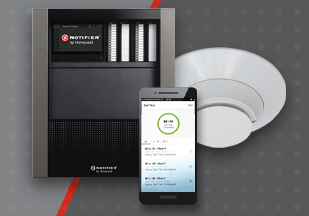
- First UL-approved self-testing smoke detectors automate testing and system maintenance
- New products integrate with Honeywell’s all-in-one cloud-based Connected Life Safety Services platform, further improving ease of installation, maintenance and compliance
Honeywell launched the first fire alarm system with UL-approved self-testing smoke detectors that can be tested automatically, changing the way fire and life safety systems are installed, tested and maintained.
The NOTIFIER INSPIRETM fire alarm system with Self-Test detectors is designed to help create a safer building environment by increasing facility managers awareness of system needs while equipping service providers with digital self-testing tools that streamline maintenance and support regulatory compliance and system uptime.
NOTIFIER INSPIRE is an all-in-one fire system that delivers reliable protection, scalability, efficient monitoring, as well as flexible and timely reporting. It helps enhance fire technician efficiency as it is designed to scale based on the buildings’ needs, minimizes the need for equipment changes, and provides secure connectivity.
“Honeywell is integrating intelligence across all aspects of fire and life safety systems,” said Jurgen Van Goethem, global president, Fire, Honeywell.
“By digitalizing the most essential system in the building, we’re creating efficiencies during commissioning and maintenance, we’re further improving system reliability and we’re improving the end-user experience. We’re also working to change building owners’ mindsets to think about fire and life safety systems not just as a necessary system to be able to occupy the building, but as a system with a wealth of data that going forward,we can tap into to ultimately better protect lives. This will help move the industry toward the creation of safer and more compliant buildings.”
A connected fire and life safety ecosystem
NOTIFIER INSPIRE series with Self-Test smoke detectors are securely enabled through Honeywell’s Connected Life Safety Services (CLSS) cloud-based platform. CLSS provides real-time visibility into the fire system to installers, service technicians and facility managers, and allows technicians to diagnose and troubleshoot problems ahead of time, improving first-time fix rates and reducing time spent on-site.
A life safety system that grows with a building
NOTIFIER INSPIRE features modularity for easy expansionand upgrades, creating a system that grows with a building. The system reduces the amount of equipment needed, further decreasing potential maintenance, replacement parts and overall inventory management. Its modern and intuitive touchscreen display helps minimize human error while providing a stylish aesthetic.It can help enhancetechnician efficiency by minimizing disruption, maximizing remote productivity and supporting compliance.
A solution that self-tests and detects
NOTIFIER Self-Test eliminates manyof thephysical barriersduring test and maintenancesuch as locked rooms, high ceilingsand other hard-to-access spaces–areas that maygo untested, which can ultimately put buildings at risk. The detectors introduce small amounts of heat and smoke into their owndetection chambers, testing both the photo and thermal sensors as well as verifyingthatsmoke entry points are free of obstruction.
Most importantly, a single technician can initiate the test at the NOTIFIER INSPIRE panel for the entire building, minimizing disturbances in working spaces and eliminating the need to access difficult-to-reach areas like elevator shafts. The inspection report is digitized, delivered electronically via the CLSS application within minutes, a task that previously took as much as one hour, and createsa complete end-to-end electronic audit trail to support full compliance.

Honeywell Building Technologies (HBT) is transforming the way every building operates to help improve the quality of life. Commercial building owners and operators use their hardware, software and analytics to help create safe, efficient and productive facilities.visit: www.honeywell.com
See more articles on: Honeywell
Source: honeywell.com
Source: honeywell.com
